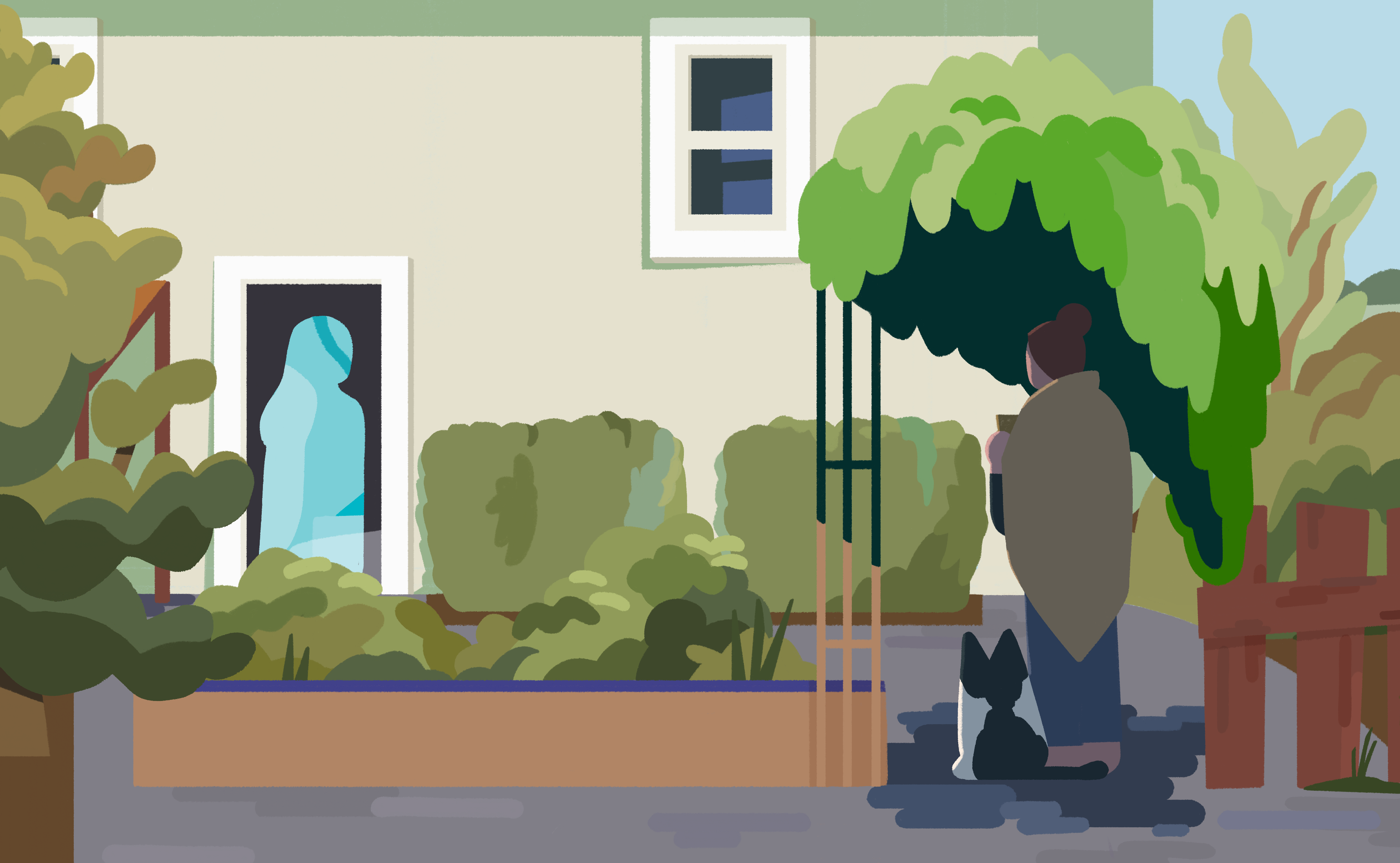
SHIDEH GHANDEHARIZADEH / NEXTGENRADIO
What is the meaning of
home?
Anna Lueck speaks with Laura Green, co-founder of the Portland Grief House. Adrift after a series of losses, Green began holding gatherings online, and, later, in her mother’s North Portland house, so that the bereaved have a place to mourn, celebrate, and connect in community. Two months ago, Green’s mother died in the backyard. Once, her mother was her home. Now, Green’s definition of home is changing as she processes her absence.
Creating space in Portland to grieve and honor the complexity of loss
Listen Here
Click here for audio transcript
Laura Green:
(Floorboard creak)
Here, on my right, this is our big, big room where we do bigger gatherings like yoga happens here. We get to come in and contemplate your death, like practice, practice death.
I am Laura Green, and I’m the co-founder of the Portland Grief House. I’m my mother’s daughter, um. We’re sitting in the living room of the grief house, which is — which was my mother’s house.
This space holds, um, many, many things.
Our hope is that people will feel able to use it as a space where they can like be all of the things that they are, you know, like including but not limited to like broken by loss.
In the culture that I exist in, I feel like I often am asked to compartmentalize myself and show just little bits of myself to people.
And there’s this sort of expectation like, well, so you go away and get better and at some point you can rejoin us when you’re all, all set and fixed. But what if there was a place where you could just be like. I am knitting and you are, I don’t know, like making oatmeal. And we’re just humans.
Once a month in the winter, we do community dinners where everyone brings a dish.
I like that a lot about this particular community. We haven’t segregated ourselves into like healers and broken ones. Most of the people are both things.
So many people have given us things, like so many people have contributed so many things to the, to the house and the project,
My friend Elena made that, those two beautiful pieces of art underneath the shells.
That picture, that’s standing, sitting inside that plant, one of our collaborators made a flower arrangement. And she printed that picture of my mother.
So my mom was in the convent for 20 years, she was a Maryknoll nun.
For my first seven years, she cleaned houses and brought me with her because she didn’t want to leave me.
(Floorboard creaks)
This is my mom’s bedroom.
I mean, look how she kept everything like this is my 20 plus book club certificate that I got in middle school because I read more than 20 books.
And she kept this, but she doesn’t have my, like, my college diploma. Isn’t that good?
We went to the doctor in the beginning of the summer, and the doctor is like … She will die of old age. We weren’t trying to figure out how to keep her alive. You’re trying to figure out how to, like, let her death come.
I came here and thought she was alive And I walked out in the backyard.
(Sound of birds chirping, cars passing by)
And then I saw her. And it was very clear she was dead instantly. Like, I didn’t have a minute where I was like, ‘maybe my mom has fallen.’ I was like, ‘Oh, my mother’s dead.’
I mean I think my mother was certainly home. But now that she’s dead, I don’t feel homeless.
Doing the work in my mother’s house now, after she’s dead, feels uncharted. I knew that’s what would happen. And also now that it’s happening, I don’t, I don’t know what comes next. And what comes next? And what comes next?
I’m incredibly grateful that I get to be in the house, though.
In 2017, Laura Green felt like she was falling. A beloved aunt died in March. Her cousin’s son died by suicide on Christmas Eve. In between, the family cat died.
“I just couldn’t catch up,” Green said, legs tucked under her on a brown leather couch. “Every time I felt like I had paved over the broken parts, more broke deeper down, and the pavement just crumbled and fell into the cracks.”
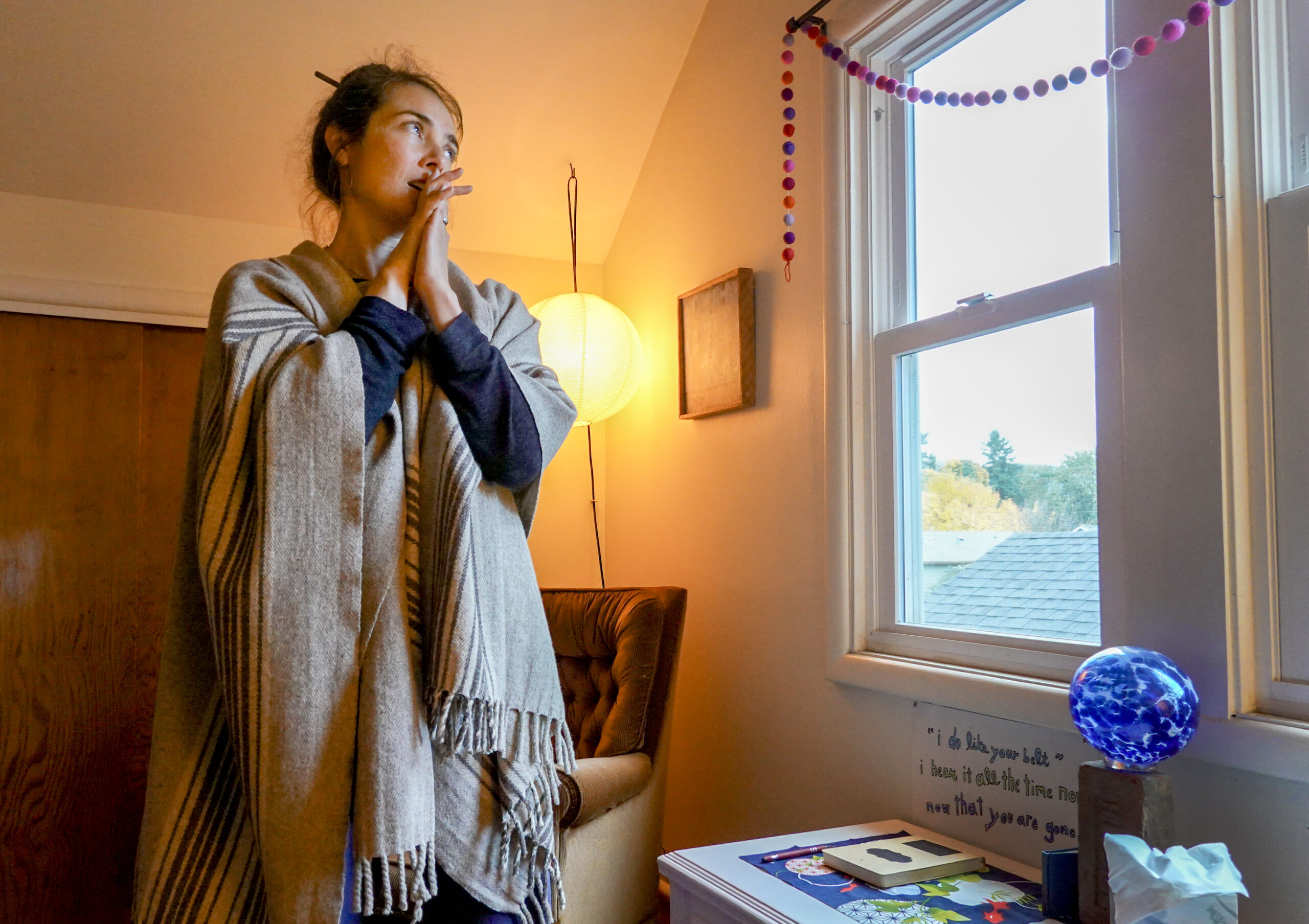
Portland Grief House co-founder Laura Green stands on the upper floor of the Grief House in Portland, Ore. on Oct. 23, 2023. Green began officially facilitating in 2019. Many Grief House activities now take place in the North Portland home — which was also home to her mother before she died.
ANNA LUECK / NEXTGENRADIO
When she couldn’t find a place to help her heal, she decided to make it herself. In 2019, she officially founded the Portland Grief House, along with her lifelong friend, Sascha Demerjian.
Now, the Grief House offers space to process all types of pain. Green, Demerjian, and other healers invite people grieving any type of loss — a death, the end of a relationship — to sit with that pain while sharing food, doing art or lying in savasana. Soon, Green hopes to add a record player for guests to play tracks significant to their loved ones.
“I would love for this house to be a place in the city where people could come and feel connected to each other,” Green said.
While some of the Grief House meetings take place on Zoom, most draw visitors into a two-story home and sprawling garden in North Portland at the intersection of Fessenden Street and Allegheny Avenue. Just inside the front door in the living room, visitors can play cards, drink tea or pet a 17-year-old cat named Squee in front of a crackling fireplace.
Along with the Grief House, this building was also home to Green’s mother. But, this past summer, her mother died in the house’s garden. Four years into this project, Laura Green is once again looking for solid ground.
Birds chirped and flitted between a sea of green leaves, drowning out the sound of nearby traffic.
“I love this tree,” Green said, looking at a rowan tree with a forked trunk. “She’s kind of like two trees, but also like one … One person at a gathering was like, ‘Oh, it’s like you and your mother.’”
Green says she and her mother, Grace Green, were always close. Her mother entered the convent at age 17, but decided to leave two decades later to have a child. Until recently, Laura Green, said her father was not in their life. Throughout her childhood, it was just her and her mother, scraping by.
“She cleaned houses and brought me with her because she didn’t want to leave me,” Laura Green said, smiling each time she recalled memories of her mother.
Walking along a brick pathway in the backyard, Green paused under an arch bursting with vines.

Green holds a lock of her mother’s hair, which she collected before her mother was buried.
ANNA LUECK / NEXTGENRADIO
“This is where my mother died. There were clippers there. She had her robe on. She looked fine, but just not alive.”
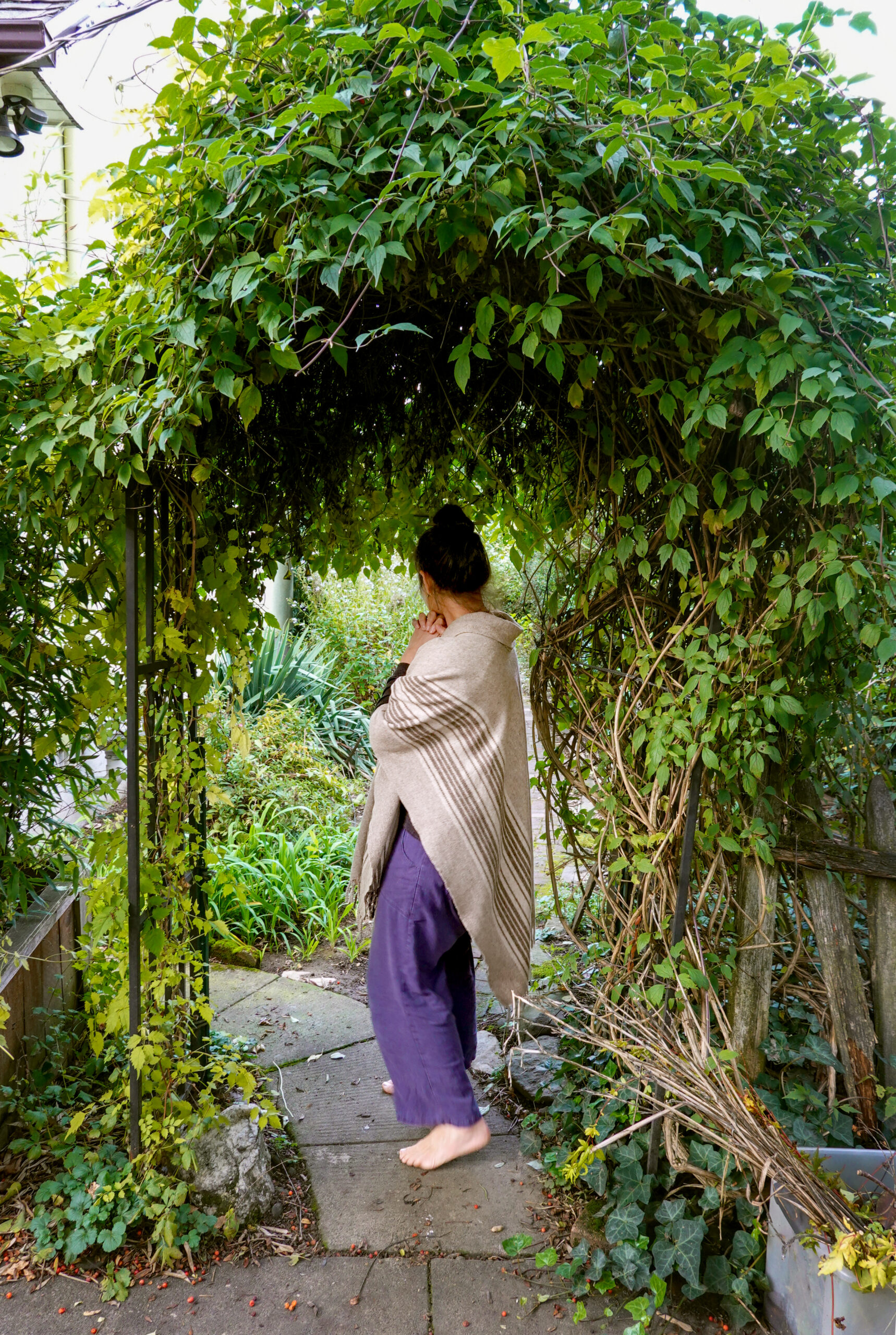
On the day her mother died, Green found her body under an archway in the backyard. “I laid in it the other day,” Green says, “to just see what it was like. And it’s lovely.”
ANNA LUECK / NEXTGENRADIO
“This is where my mother died,” she said. “There were clippers there. She had her robe on. She looked fine, but just not alive.”
Earlier that day, as Green left the house around 3 p.m. for errands, her mother was washing dishes. When she returned at 4:30 p.m., the house was empty. She saw her mother’s body on the garden ground and knew immediately that she was dead.
It wasn’t until 9:30 p.m. that her body was collected. In those five hours, Green crept closer to her mom’s body, until she felt able to touch her skin.
“I have a different feeling about bodies now, dead bodies, than I did before,” Green said. “Or at least her body, her dead body.”
The second floor of the Grief House is filled with airy light and soft surfaces. One room holds a yoga studio with fairy lights on the walls and hanging bundles of herbs. Another holds a community bookshelf beside a wood ladder leading to a small loft. Once, after a gathering at the house, Green said she discovered three young women had climbed up to this space together.
“They hadn’t known each other before,” she said, “but they were telling each other their grief stories … It felt so nice to be like, that’s who I am now. I can be the one who has the house and leaves the young girls talking about their deep hearts.”
Green stepped barefoot down the creaky stairs and turned into a room with a “private” sign on the door. Compared to the rest of the house, this room is more bare: there is a bed stacked with linens, a bookshelf full of framed photos.
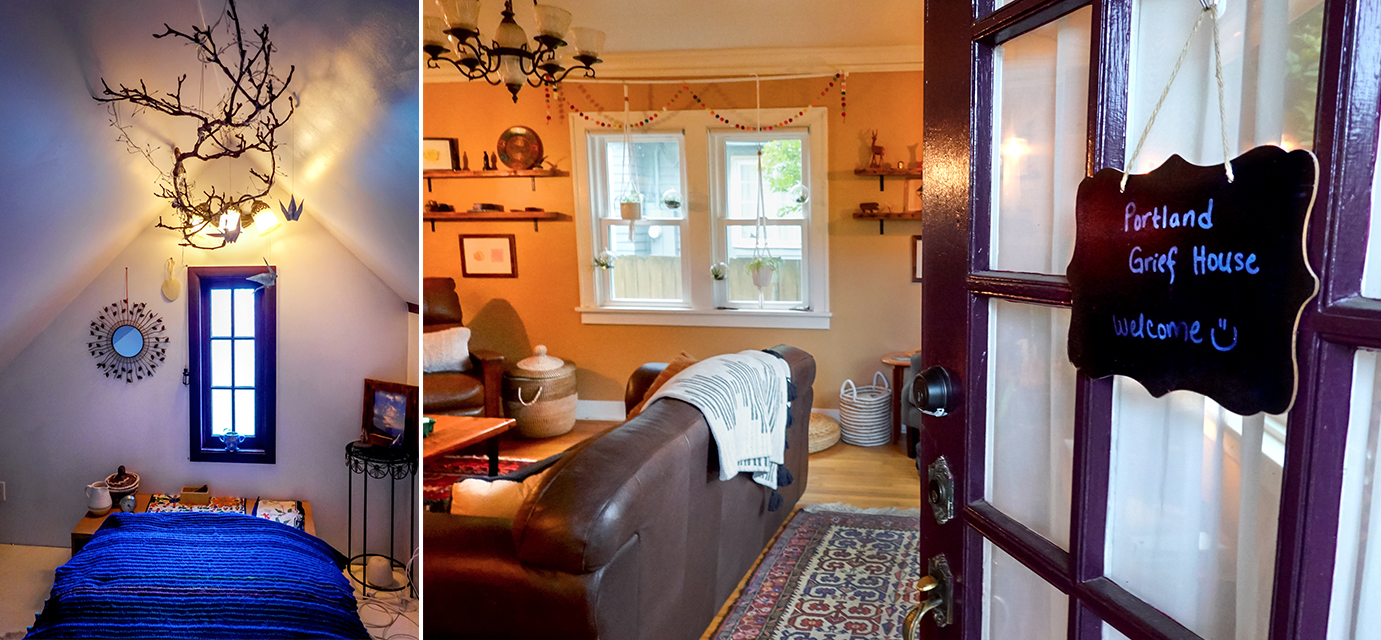
(Left) This room — one of three on the Grief House’s upper floor — is sometimes a massage space, sometimes a bedroom. Green, who’s a massage therapist, strives to bring the physical body into people’s healing journeys, whether through massage, yoga or vibrational healing.
(Right) In the Grief House’s front room, Green and her co-founder, Sascha Demerjian, wanted to create a space that welcomed visitors experiencing their grief in a wide variety of ways. The room centers around a warm fireplace and is filled with games, Oracle cards and art that has been gifted to the project over the years. While the house is currently only open to the public for events, Green hopes to have enough volunteers in the future to allow people to visit at any time.
ANNA LUECK / NEXTGENRADIO
“This is my mother’s room,” Green said, picking up a photo collage scrawled with blue and purple crayon — one of the many art pieces she made for her mother.
Green said her mother kept everything.
“When she was alive, she told me all the time that I was perfect,” she said. ‘“She was perfect.”
These days, Green is looking to the future. She has big dreams for the Grief House: finding enough volunteers to keep the house open more often, buying land outside the city and expanding to other cities. What to do with her mother’s room feels murkier. Eventually, a new tenant may move in. For now, there are clothes to sort, and photos and childhood toys to sift through and honor.
“Doing the work in my mother’s house, in the house in which my mother lived and died … feels uncharted,” Green said. “I knew that’s what would happen. And that was the plan. And also, now that it’s happening, I don’t know what comes next.”
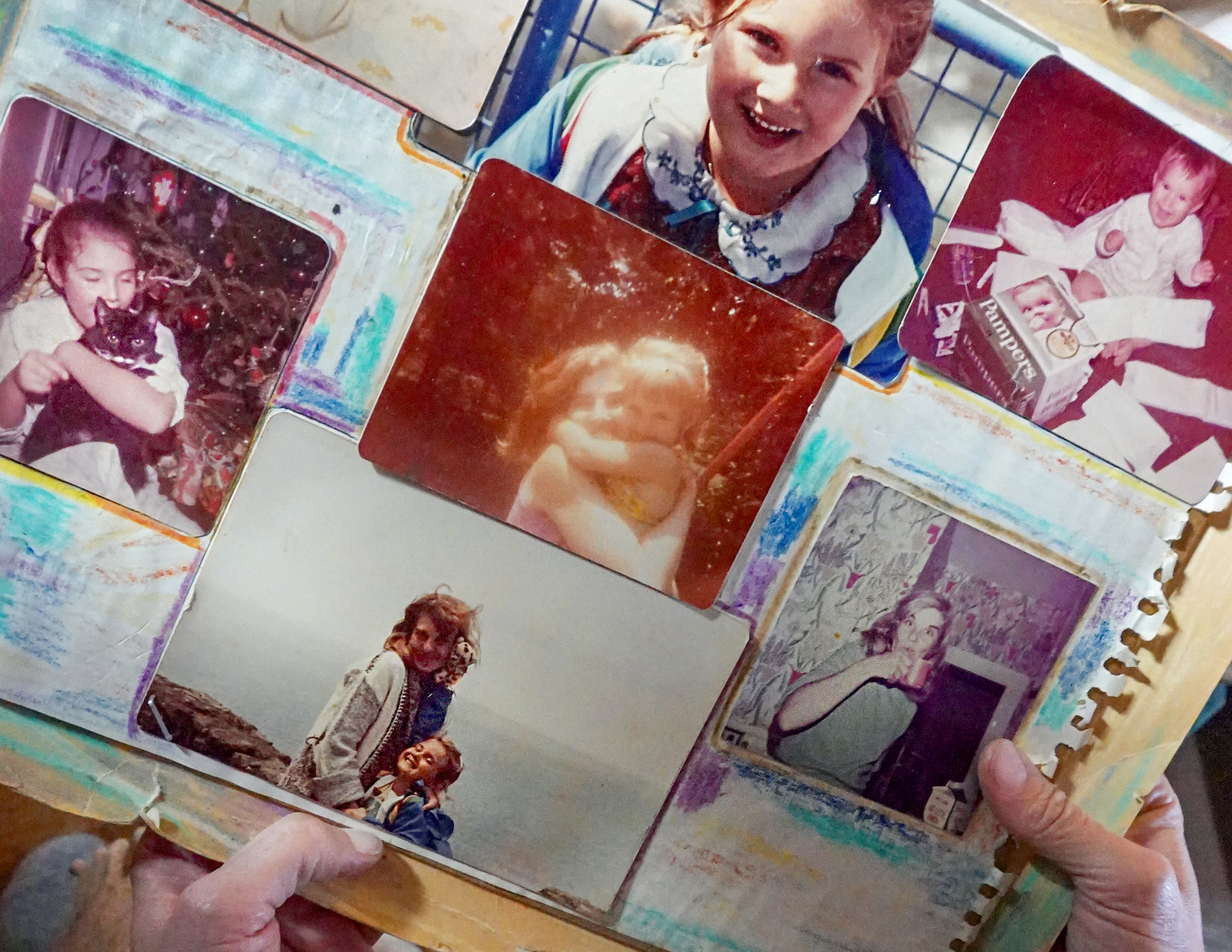
Green holds a photo collage she made for her mother as a child. “We lived in a three room apartment and had no money. But she paid for me to go to art classes,” Green says. “My mom was so good at letting me do stuff, all my life.”
ANNA LUECK / NEXTGENRADIO
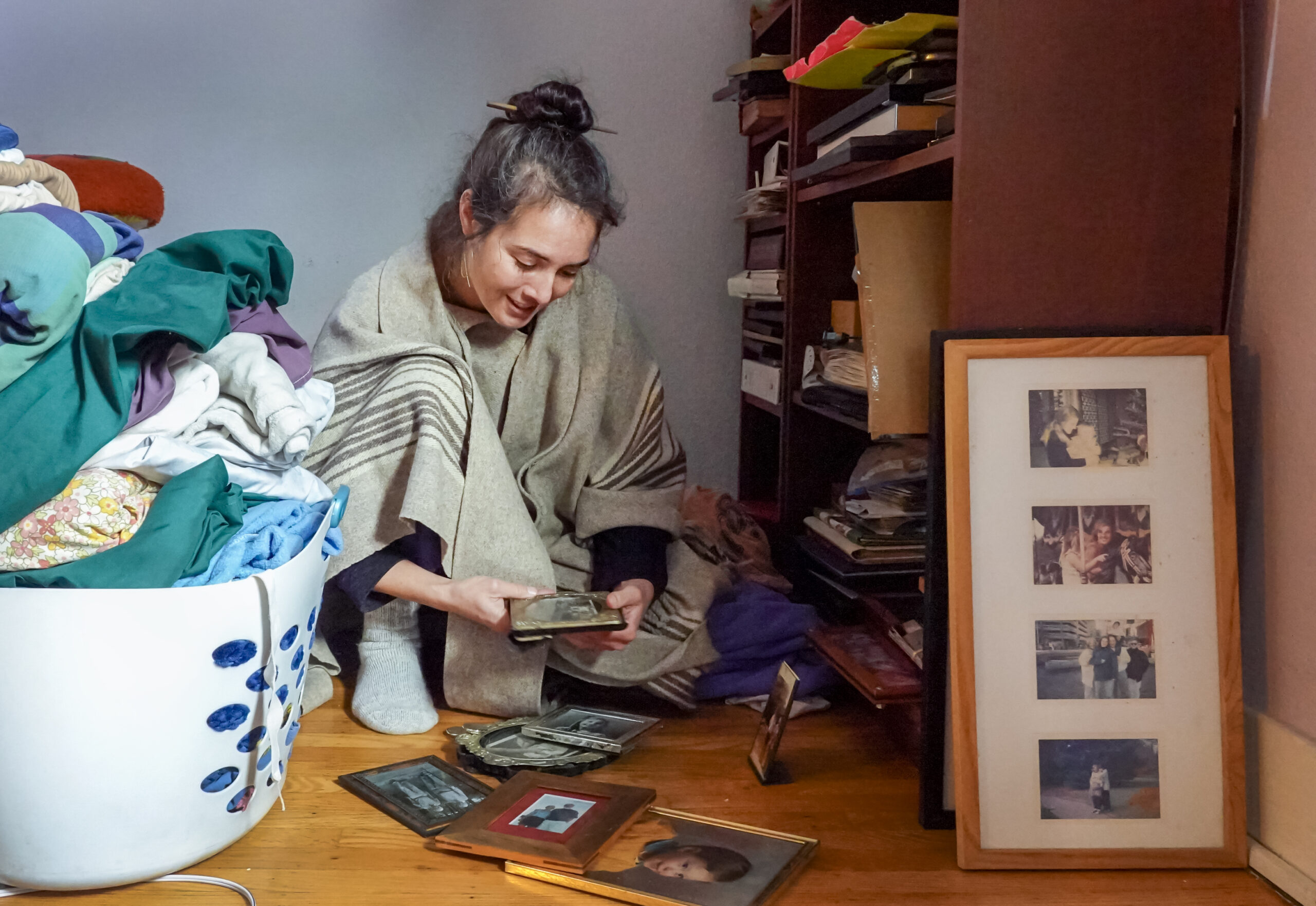
At the foot of her mother’s bed, Green sorts through her mother’s clothes and photos following her mother’s death. “Taking apart my mother’s room has felt really hard for me,” Green says. “I’m incredibly grateful that I get to be in the house, though.”
ANNA LUECK / NEXTGENRADIO
